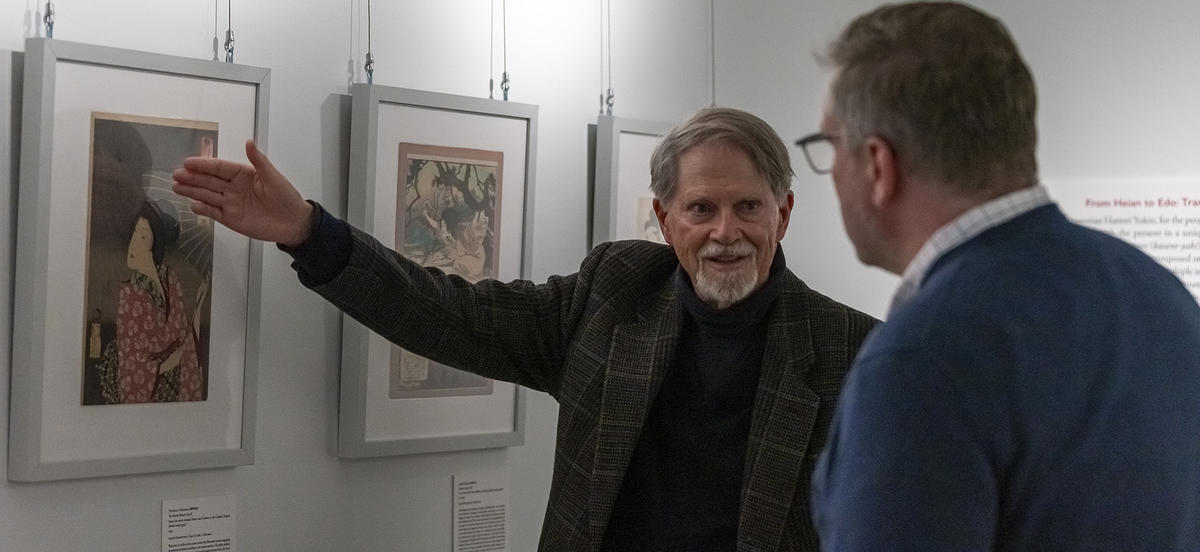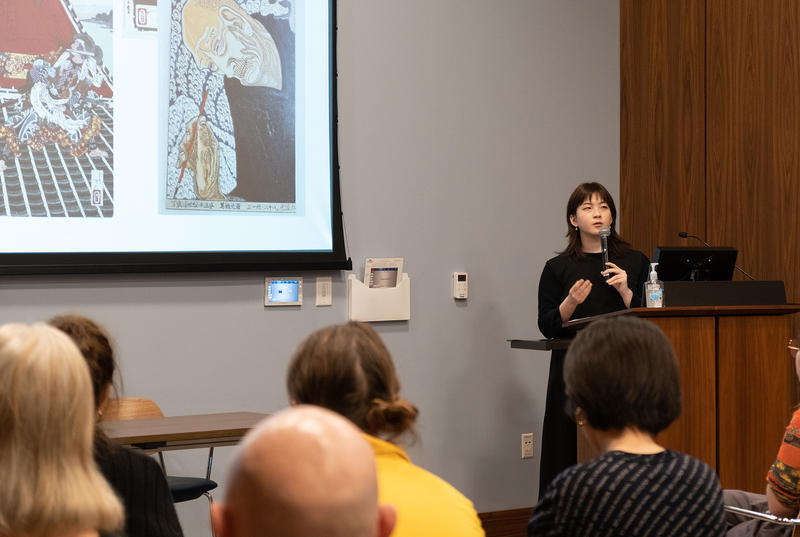Picturing Pleasure

Arnold Satterthwait ’66 discusses the works in his collection. Photo by Patrick Montero.
Details
An exhibition of 18th- and 19th-century prints drawn from the collection of Arnold Satterthwait '66 explores Japan’s enticing “floating world.”
As the Tokugawa shogunate rose to power in early 17th century Japan, it capped nearly two centuries of feudal infighting and ushered in an era of relative peace and sweeping societal changes across the island nation. The Edo Period, the era of the shogunate’s rule spanning 1603-1868, was also characterized by Japan’s stringent isolationist policies, but a new exhibition of prints drawn from the collection of Arnold Satterthwait ’66 on view in Lutnick Library provides a vivid glimpse of Japanese culture and society at the time.
The assemblage of colorful woodblock prints and other works featured in Beyond the Floating World: Traversing Space and Time Through Ukiyo-e, curated by Stephanie Wang BMC ’24 and on view in the Library’s Rebecca and Rick White Gallery, belong to a category of Japanese art called ukiyo-e, which translates to “images of the floating world.” The concept of such a place was largely tethered to Edo, now present-day Tokyo, the seat of the shogun’s government and the site of blossoming urban culture.
To inhabit the floating world, Wang says, was to bask in hedonistic pursuits awaiting patrons in the city’s kabuki theaters, sumo matches, and its licensed pleasure quarter. Its existence stood at odds with the rigid social hierarchy installed by the shogunate, she says, but it offered a temporary escape from its rigors. In this melting pot, one person’s money was as good as the next’s, and privilege could be purchased if one’s purse was full enough.
“After a few hours of indulgence and carefree pleasure,” Wang, a history of art major, writes in the catalog that accompanies the exhibition, “party-goers were expected to resume their assigned roles, and the neo-Confucian social order was to continue on its appointed course with only minor disruption.”

For many, art was the entryway to the floating world. The dynamic and affordable mass-produced prints featuring the actors, courtesans, wrestlers, and other characters who populated the floating world were distributed through Edo’s network of more than 600 publishers, says Satterthwait, whose collection has grown to include more than 130 such prints. Their emergence marked a dramatic shift in the accessibility of art as, previously, paintings and other objects were reserved for the higher ranks of society, those with means and connections.
“They were the mass media of the time,” says Satterthwait. “They covered every interest of the townspeople, which could be kabuki, beautiful courtesans, and, eventually, travel and history. They catered to every interest.” They were incredibly affordable to boot, Wang adds, with costs comparable to a bowl of buckwheat noodles.
Wang’s interest in ukiyo-e was kindled in a class led by Associate Professor of East Asian Languages and Cultures and Visual Studies Erin Schoneveld last spring, where students studied many of Satterthwait’s prints on a weekly basis. That experience also laid the groundwork for her to curate Beyond the Floating World. For the exhibition’s trajectory, Wang opted to explore the artform’s evolution beyond Edo’s pleasure quarters to include landscapes and its continued influence among 21st-century artists. The exhibition includes supplementary works and objects drawn from the collections of Haverford, Bryn Mawr, and University of Pennsylvania, such as a vitrine containing tools and pigments used by the artist, block cutter, printer, and publisher — the “ukiyo-e quartet” — to churn out prints.
Included in the exhibition are prints by Katsushika Hokusai and Utagawa Hiroshige, two of ukiyo-e's most-recognized names, to portray the artform’s ability to transform how people perceived movement and space and its influence beyond the Edo’s tangible sites. More recent works, including a reproduction of Hokusai’s instantly recognizable "The Great Wave off Kanagawa" by artist David Bull, highlight ukiyo-e’s persistent influence on 21st-century artists.
Nearly half of Satterthwait’s collection is on loan to the College, a decision he made to ensure its visibility and to make them available for students and faculty to examine. He says he opted not to send them to any museums in Southern California, where he lives, since they might not receive the attention they deserve.
“I figured they’d end up in some museum’s basement and only be exhibited once every 30 years,” he says. “[At Haverford], people can study them and see them.”
The exhibition is a confluence of firsts: this is the first exhibition Wang, whose work was supported by Joseph E. O'Donnell Research Internship, has curated, and it’s also the first time Satterthwait’s collection has been on view publicly. True to Haverford’s commitment to experiential learning, curating the exhibition, preparing its didactic materials, and crafting the lengthy catalog essay have spurred Wang to apply for museum internships before she pursues her graduate studies in East Asian art history.
Beyond the Floating World: Traversing Space and Time Through Ukiyo-e is on view through July 5. Gallery hours are 10 a.m. to 6 p.m. daily through May 18. After May 18, Lutick Library will be closed on weekends.




